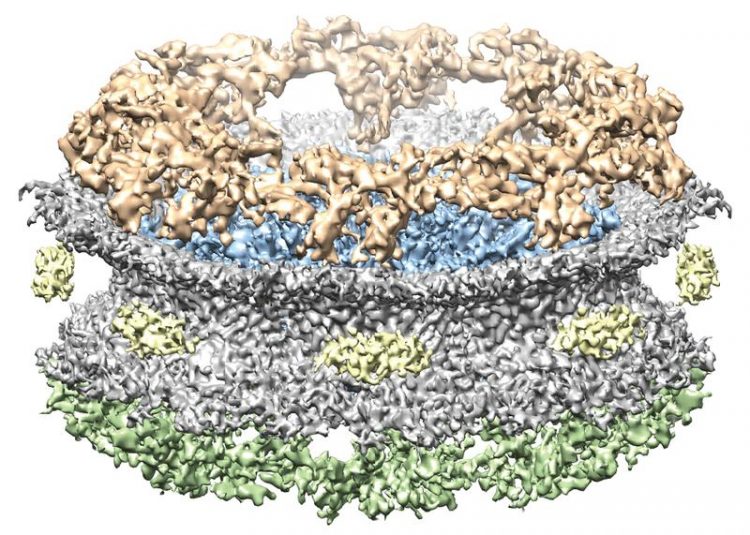High-performance microscope displays pores in the cell nucleus with greater precision

The nuclear pore complex is comprised of several layered rings: the cytoplasmic ring (gold), the spoke ring within the pore (blue) and the nucleoplasmic ring (green). UZH
An active exchange takes place between the cell nucleus and the cytoplasm: Molecules are transported into the nucleus or from the nucleus into the cytoplasm. In a human cell, more than a million molecules are transported into the cell nucleus every minute.
In the process, special pores embedded in the nucleus membrane act as transport gates. These nuclear pores are among the largest and most complex structures in the cell and comprise more than 200 individual proteins, which are arranged in a ring-like architecture.
They contain a transportation channel, through which small molecules can pass unobstructed, while large molecules have to meet certain criteria to be transported. Now, for the first time, an UZH research team headed by Professor Ohad Medalia has succeeded in displaying the spatial structure of the transport channel in the nuclear pores in high resolution.
“Molecular gate” discovered in the pore channel
For their study, the scientists used shock-frozen specimens of clawed frog oocytes. With the aid of cryo-electron microscopes, Medalia’s team was able to display the miniscule nuclear pores, which were merely a ten thousandth of a millimeter in diameter, at a considerably higher resolution than ever before. As a result, they uncovered new details:
“We discovered a previously unobserved structure inside the nuclear pore that forms a kind of molecular gate, which can only be opened by molecules that hold the right key,” explains Medalia. This “molecular gate” is the so-called spoke ring, which is sandwiched between two other rings and extends inside the nuclear pores. The gate itself consists of a fine lattice, which enables small molecules to slip through unobstructed.
The new, high-resolution presentation of the nuclear pore structure leads to a better understanding of why certain molecules are allowed to pass through the nuclear pores while others are turned away. It also helps improve our understanding of the development of some diseases that involve a defective transportation to the nuclear pores – such as intestinal, ovarian and thyroid cancer.
Literature:
M. Eibauer, M. Pellanda, Y. Turgay, A. Dubrovsky, A. Wild, and O. Medalia: Structure and Gating of the Nuclear Pore Complex. Nature Communications. June xx, 2015. doi: 10.1038/ncomms8532
Cryo-electron microscopy at the University of Zurich
Cryo-electron tomography is a method to render cell structures three-dimensionally visible in their natural environment in high resolution using both electron microscopy and computer imaging. The cells are shock-frozen in liquid nitrogen at minus 190 degrees. The cell structures remain intact in a quasi-living state, which means that they no longer need to be pre-treated with harmful chemicals. Extremely powerful electron beams also enable scientists to study thick sections or entire flat specimens (up to approximately 500 nm).
Ohad Medalia, a pioneer in the field of cryo-electron microscopy, was appointed as a Professor of Biochemistry at the University of Zurich in 2010. Thanks to the generous support from the Mäxi Foundation, two high-performance electron microscopes of the type “Polara” and “Titan Krios” could be purchased. Today, they are operated together with UZH’s Center for Microscopy and Image Analysis and have expanded UZH’s range of technology considerably.
Contacts:
Prof. Ohad Medalia
Department of Biochemistry
University of Zurich
Tel.: +41 44 635 55 22
Email: omedalia@bioc.uzh.ch
Nathalie Huber
Media Relations
University of Zurich
Tel.: +41 44 634 44 64
Email: nathalie.huber@kommunikation.uzh.ch
Media Contact
All latest news from the category: Life Sciences and Chemistry
Articles and reports from the Life Sciences and chemistry area deal with applied and basic research into modern biology, chemistry and human medicine.
Valuable information can be found on a range of life sciences fields including bacteriology, biochemistry, bionics, bioinformatics, biophysics, biotechnology, genetics, geobotany, human biology, marine biology, microbiology, molecular biology, cellular biology, zoology, bioinorganic chemistry, microchemistry and environmental chemistry.
Newest articles

NASA: Mystery of life’s handedness deepens
The mystery of why life uses molecules with specific orientations has deepened with a NASA-funded discovery that RNA — a key molecule thought to have potentially held the instructions for…

What are the effects of historic lithium mining on water quality?
Study reveals low levels of common contaminants but high levels of other elements in waters associated with an abandoned lithium mine. Lithium ore and mining waste from a historic lithium…

Quantum-inspired design boosts efficiency of heat-to-electricity conversion
Rice engineers take unconventional route to improving thermophotovoltaic systems. Researchers at Rice University have found a new way to improve a key element of thermophotovoltaic (TPV) systems, which convert heat…



